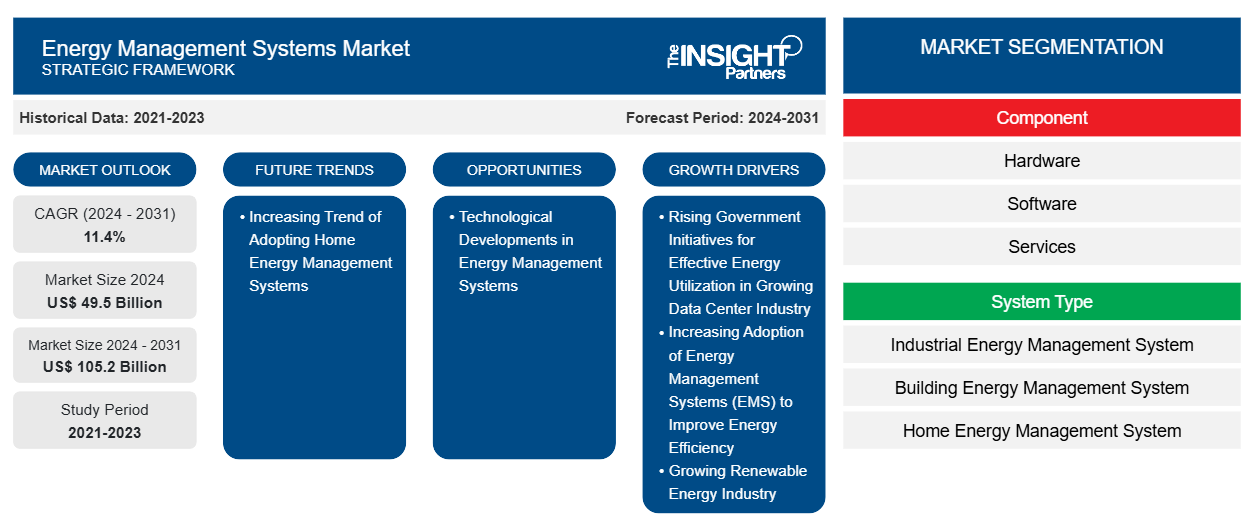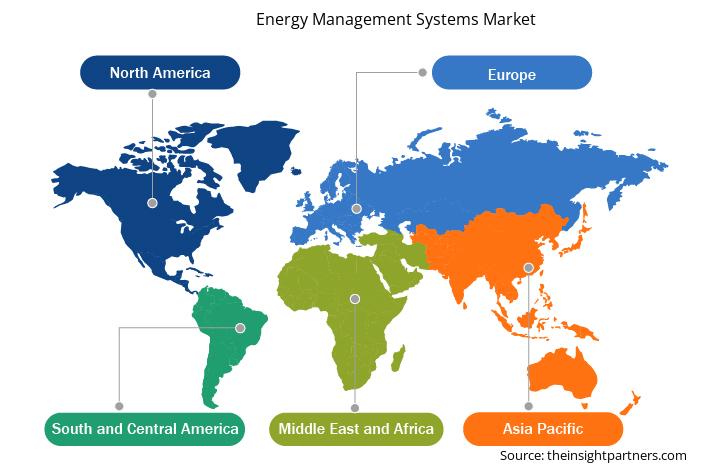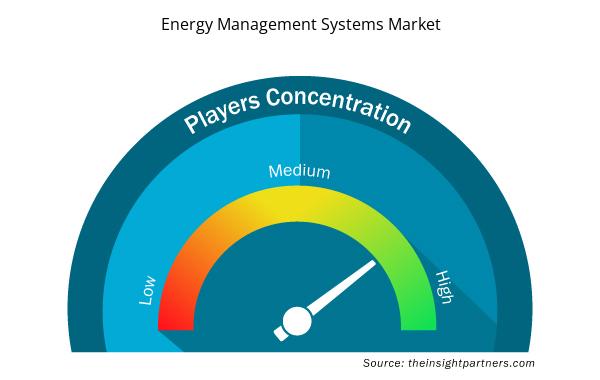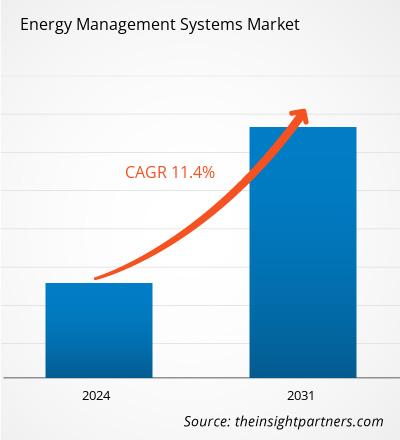Le marché des systèmes de gestion de l'énergie devrait atteindre 105,2 milliards de dollars US d'ici 2031, contre 49,5 milliards de dollars US en 2024. Le marché devrait enregistrer un TCAC de 11,4 % entre 2024 et 2031. Les avancées technologiques croissantes dans le domaine des systèmes de gestion de l'énergie devraient apporter de nouvelles tendances au marché dans les années à venir.
Analyse du marché des systèmes de gestion de l'énergie
Les systèmes de gestion de l'énergie sont de plus en plus adoptés par divers secteurs, tels que l'industrie manufacturière, l'automobile, les télécommunications et l'informatique, le résidentiel et le commercial, ainsi que l'énergie et les services publics. Un système intelligent de gestion de l'énergie (SEMS) est une technologie qui exploite la connectivité de l'Internet des objets (IoT) pour suivre, mesurer, contrôler et optimiser la consommation d'énergie d'un bâtiment ou d'un complexe de bureaux, contribuant ainsi à une gestion efficace de la consommation énergétique dans divers secteurs. La multiplication des initiatives des gouvernements et des entreprises privées en faveur des économies d'énergie, des objectifs de développement durable et des incitations à la réduction des émissions de carbone pour les acteurs industriels et autres clients résidentiels et commerciaux du monde entier devrait encourager les entreprises du marché des SEMS à adopter des développements stratégiques clés tels que le développement de produits, les fusions, les partenariats et les collaborations. Par exemple, en mai 2024, Siemens Smart Infrastructure et Emporia ont lancé une solution de surveillance énergétique domestique appelée « Inhab Energy Monitor ». Cette nouvelle solution de surveillance énergétique réduit la consommation d'énergie des habitations grâce à un suivi continu de la consommation. En avril 2024, Powerley (une entreprise de gestion de l'énergie domestique) a lancé Powerlay Live pour aider les services publics à mettre en place des centrales électriques virtuelles au niveau des foyers, permettant ainsi aux clients de surveiller la consommation de leurs appareils et de prévoir et de contrôler précisément la charge.
Aperçu du marché des systèmes de gestion de l'énergie
Un système de gestion de l'énergie est une solution globale permettant de surveiller, de contrôler et d'optimiser la consommation d'énergie au sein d'une installation, d'une organisation ou de plusieurs sites. Ce système intègre matériel, logiciels et outils d'analyse pour fournir des informations en temps réel sur les habitudes de consommation, identifier les pistes d'amélioration et mettre en œuvre des stratégies d'amélioration de l'efficacité énergétique et de la durabilité. Les principales fonctionnalités des systèmes de gestion de l'énergie comprennent l'acquisition de données, la surveillance, l'automatisation et le contrôle, la gestion de la demande et de la charge, l'analyse et le reporting de la consommation d'énergie, ainsi que l'intégration des ressources énergétiques décentralisées. Les principaux utilisateurs finaux de ces systèmes à travers le monde sont les secteurs de l'industrie manufacturière, les bâtiments résidentiels et commerciaux, les secteurs de l'énergie et des services publics, les centres de données, le commerce de détail, l'hôtellerie et les installations industrielles (hors production).
Les capteurs et les appareils de mesure sont des composants essentiels de tout système de gestion de l'énergie. Ces outils fournissent des données précises sur la consommation énergétique du site, du bâtiment, de la salle et des installations, permettant une analyse détaillée pour identifier les inefficacités et cibler les axes d'amélioration. Des capteurs avancés mesurent des variables telles que la température, l'humidité et les performances des appareils pour offrir une vision globale de la consommation énergétique. Les plateformes EMS de pointe utilisent l'intelligence artificielle (IA) et des algorithmes d'apprentissage automatique pour prédire les besoins énergétiques, identifier les tendances et mettre en évidence les inefficacités. Ces technologies prédisent également les schémas de consommation énergétique, permettant ainsi une prise de décision plus éclairée.
Les principaux facteurs de croissance du marché des systèmes de gestion de l'énergie sont les initiatives gouvernementales visant à optimiser l'utilisation de l'énergie dans le secteur en pleine expansion des centres de données, l'adoption croissante de ces systèmes pour améliorer l'efficacité énergétique et le développement du secteur des énergies renouvelables. Cependant, les obstacles à la réalisation de projets de systèmes de gestion de l'énergie devraient freiner la croissance du marché. Les avancées technologiques en matière de systèmes de gestion de l'énergie devraient créer des opportunités pour les entreprises présentes sur ce marché au cours de la période de prévision. De plus, la tendance croissante vers les systèmes de gestion de l'énergie domestique devrait influencer la trajectoire de croissance du marché entre 2024 et 2031.
Personnalisez ce rapport en fonction de vos besoins
Vous bénéficierez d'une personnalisation gratuite de n'importe quel rapport, y compris des parties de ce rapport, ou d'une analyse au niveau des pays, d'un pack de données Excel, ainsi que de superbes offres et réductions pour les start-ups et les universités.
Marché des systèmes de gestion de l'énergie : perspectives stratégiques

- Obtenez les principales tendances clés du marché de ce rapport.Cet échantillon GRATUIT comprendra une analyse de données, allant des tendances du marché aux estimations et prévisions.
Moteurs et opportunités du marché des systèmes de gestion de l'énergie
Tendance croissante à l'adoption de systèmes de gestion de l'énergie domestique
Un système de gestion de l'énergie domestique surveille et optimise le flux d'énergie au sein d'une maison afin d'atteindre un objectif donné. Des réglementations ambitieuses en matière de consommation d'énergie dans le secteur résidentiel stimulent de plus en plus les systèmes de gestion de l'énergie domestique. Par exemple, la norme européenne relative aux toits solaires, telle que la directive sur la performance énergétique des bâtiments, a été introduite début mai 2023 et devrait permettre l'installation de 150 à 200 GW supplémentaires de panneaux solaires sur les toits de l'UE entre 2026 et 2030, soit suffisamment pour alimenter 56 millions d'habitants. Cela signifie que le plein potentiel du photovoltaïque sur les toits sera progressivement exploité dans les années à venir.
Croissance de l'industrie des énergies renouvelables
La production d'électricité à partir de combustibles fossiles est un contributeur majeur aux émissions de gaz à effet de serre (GES), responsables du changement climatique. C'est pourquoi de nombreux gouvernements à travers le monde s'attachent à réduire leur empreinte carbone et à opérer une transition vers les énergies propres, ce qui les incite à investir dans la production d'énergie verte. L'utilisation des énergies solaire et éolienne est en hausse en raison de l'intérêt croissant pour les énergies propres et vertes, des préoccupations croissantes liées au changement climatique et de la multiplication des initiatives gouvernementales visant à encourager le recours aux énergies renouvelables. Selon l'Agence internationale de l'énergie (AIE), la production mondiale d' électricité renouvelable devrait dépasser 17 000 térawattheures (TWh) d'ici la fin de la décennie, soit une augmentation de près de 90 % par rapport à 2023 ; cela devrait permettre de répondre aux besoins combinés en électricité de la Chine et des États-Unis en 2030. Plusieurs objectifs importants en matière d'énergies renouvelables devraient être atteints au cours des cinq prochaines années. En 2025, la production d'électricité issue des énergies renouvelables devrait dépasser celle du charbon. En 2026, la production d'électricité éolienne et solaire devrait dépasser celle du nucléaire. Ensuite, en 2029, la production d’électricité à partir du solaire photovoltaïque devrait dépasser la production d’énergie hydraulique et devenir la plus grande source d’énergie renouvelable au monde – et il en va de même pour la production d’énergie éolienne qui devrait dépasser l’énergie hydraulique d’ici 2030.
Analyse de segmentation du rapport sur le marché des systèmes de gestion de l'énergie
Les segments clés qui ont contribué à l’élaboration de l’analyse du marché des systèmes de gestion de l’énergie sont les composants, le type de système et l’industrie d’utilisation finale.
- En termes de composants, le marché se divise en matériel, logiciels et services. Le segment matériel a dominé le marché en 2024.
- Selon le type de système, le marché se divise en systèmes de gestion de l'énergie industriels, systèmes de gestion de l'énergie des bâtiments et systèmes de gestion de l'énergie domestiques. Le segment des systèmes de gestion de l'énergie industriels a dominé le marché en 2024.
- En fonction de l'industrie d'utilisation finale, le marché se divise en secteurs : énergie et services publics, industrie manufacturière, télécommunications et informatique, résidentiel et commercial, etc. Le segment manufacturier a dominé le marché en 2024.
Analyse des parts de marché des systèmes de gestion de l'énergie par zone géographique
Le marché des systèmes de gestion de l'énergie est segmenté en cinq grandes régions : Amérique du Nord, Europe, Asie-Pacifique (APAC), Moyen-Orient et Afrique (MEA), et Amérique du Sud et centrale. L'Amérique du Nord a dominé le marché en 2024, suivie de l'Europe et de l'Asie-Pacifique.
L'Europe dispose d'une industrie manufacturière bien établie qui utilise des technologies de pointe, telles que l'automatisation, la robotique, l'Internet industriel des objets (IoT) et l'Industrie 4.0. En Europe, les avancées technologiques ont créé un marché hautement concurrentiel pour les systèmes de gestion de l'énergie. L'Europe est l'un des plus importants constructeurs automobiles au monde. La présence de constructeurs automobiles de premier plan tels que Volkswagen AG, Stellantis NV, Mercedes-Benz Group AG, Bayerische Motoren Werke AG et Renault SA stimule la croissance du secteur. Ces constructeurs ont besoin d'électricité ou d'énergie pour fonctionner correctement, ce qui favorise l'adoption de systèmes de gestion de l'énergie. L'Allemagne est la plus grande économie d'Europe et abrite plusieurs secteurs industriels de premier plan, notamment l'automobile, l'aéronautique, l'électronique, la chimie et l'agroalimentaire. Selon l'Association des constructeurs européens d'automobiles (ACEA), les immatriculations de voitures neuves en Allemagne ont atteint environ 2,84 millions d'unités en 2023, contre 2,65 millions en 2022, soit une croissance d'environ 7 %. Le pays est le plus grand pôle automobile d'Europe, représentant plus de 25 % de la production totale de voitures particulières et environ 20 % de toutes les immatriculations de véhicules neufs en 2023. L'Allemagne était le premier producteur européen de véhicules particuliers en 2023 ; les usines du pays ont produit près de 3,10 millions d'unités, soit une croissance annuelle d'environ 17 %. Ces données indiquent que l'Allemagne dispose d'un écosystème bien établi pour la construction automobile, alimentant la demande d'électricité dans les opérations de fabrication ou de transformation, ce qui, à son tour, stimule l'adoption de systèmes de gestion de l'énergie.
Aperçu régional du marché des systèmes de gestion de l'énergie
Les tendances et facteurs régionaux influençant le marché des systèmes de gestion de l'énergie tout au long de la période de prévision ont été analysés en détail par les analystes d'Insight Partners. Cette section aborde également les segments et la répartition géographique du marché des systèmes de gestion de l'énergie en Amérique du Nord, en Europe, en Asie-Pacifique, au Moyen-Orient et en Afrique, ainsi qu'en Amérique du Sud et en Amérique centrale.

- Obtenez les données régionales spécifiques au marché des systèmes de gestion de l'énergie
Portée du rapport sur le marché des systèmes de gestion de l'énergie
| Attribut de rapport | Détails |
|---|---|
| Taille du marché en 2024 | 49,5 milliards de dollars américains |
| Taille du marché d'ici 2031 | 105,2 milliards de dollars américains |
| TCAC mondial (2024 - 2031) | 11,4% |
| Données historiques | 2021-2023 |
| Période de prévision | 2024-2031 |
| Segments couverts | Par composant
|
| Régions et pays couverts | Amérique du Nord
|
| Leaders du marché et profils d'entreprises clés |
|
Densité des acteurs du marché des systèmes de gestion de l'énergie : comprendre son impact sur la dynamique des entreprises
Le marché des systèmes de gestion de l'énergie connaît une croissance rapide, portée par une demande croissante des utilisateurs finaux, liée à des facteurs tels que l'évolution des préférences des consommateurs, les avancées technologiques et une meilleure connaissance des avantages du produit. Face à cette demande croissante, les entreprises élargissent leur offre, innovent pour répondre aux besoins des consommateurs et capitalisent sur les nouvelles tendances, ce qui alimente la croissance du marché.
La densité des acteurs du marché désigne la répartition des entreprises opérant sur un marché ou un secteur particulier. Elle indique le nombre de concurrents (acteurs) présents sur un marché donné par rapport à sa taille ou à sa valeur marchande totale.
Les principales entreprises opérant sur le marché des systèmes de gestion de l'énergie sont :
- ABB
- Schneider Electric SE
- Compagnie Générale d'Électricité
- Honeywell International Inc.
- Siemens AG
- IBM Corporation
Avertissement : Les entreprises répertoriées ci-dessus ne sont pas classées dans un ordre particulier.

- Obtenez un aperçu des principaux acteurs du marché des systèmes de gestion de l'énergie
Actualités et développements récents du marché des systèmes de gestion de l'énergie
Le marché des systèmes de gestion de l'énergie est évalué en collectant des données qualitatives et quantitatives issues d'études primaires et secondaires, notamment d'importantes publications d'entreprises, de données d'associations et de bases de données. Voici quelques-unes des principales évolutions du marché des systèmes de gestion de l'énergie :
- Schneider Electric, leader de la transformation numérique de la gestion de l'énergie et de l'automatisation nouvelle génération, a conclu un partenariat stratégique avec l'aéroport international de Noida pour proposer des solutions de gestion des bâtiments et de l'énergie. Grâce à cette collaboration, Schneider Electric déploiera des solutions complètes de gestion des bâtiments, comprenant un SCADA électrique et un système avancé de gestion de la distribution, visant à optimiser l'efficacité opérationnelle et la durabilité de l'aéroport. (Source : Schneider Electric, communiqué de presse, octobre 2024)
- ABB a lancé ABB Ability OPTIMAX® 6.4, la dernière version de son système phare de gestion et d'optimisation numérique de l'énergie. Cette solution permet de coordonner le contrôle de multiples actifs et processus industriels, d'améliorer l'efficacité énergétique, de réduire les émissions et de soutenir la décarbonation. (Source : ABB, communiqué de presse, juin 2024)
Rapport sur le marché des systèmes de gestion de l'énergie : couverture et livrables
Le rapport « Taille et prévisions du marché des systèmes de gestion de l'énergie (2021-2031) » fournit une analyse détaillée du marché couvrant les domaines mentionnés ci-dessous :
- Taille et prévisions du marché des systèmes de gestion de l'énergie aux niveaux mondial, régional et national pour tous les segments de marché clés couverts par le champ d'application
- Tendances du marché des systèmes de gestion de l'énergie ainsi que la dynamique du marché telles que les moteurs, les contraintes et les opportunités clés
- Analyse PEST et SWOT détaillée
- Analyse du marché des systèmes de gestion de l'énergie couvrant les principales tendances du marché, le cadre mondial et régional, les principaux acteurs, les réglementations et les développements récents du marché
- Analyse du paysage industriel et de la concurrence couvrant la concentration du marché, l'analyse de la carte thermique, les principaux acteurs et les développements récents pour le marché des systèmes de gestion de l'énergie
- Profils d'entreprise détaillés
- Analyse historique (2 ans), année de base, prévision (7 ans) avec TCAC
- Analyse PEST et SWO
- Taille du marché Valeur / Volume - Mondial, Régional, Pays
- Industrie et paysage concurrentiel
- Ensemble de données Excel



Report Coverage
Revenue forecast, Company Analysis, Industry landscape, Growth factors, and Trends

Segment Covered
This text is related
to segments covered.

Regional Scope
North America, Europe, Asia Pacific, Middle East & Africa, South & Central America

Country Scope
This text is related
to country scope.
Questions fréquemment posées
The energy management system market is expected to reach US$ 105,154.28 million by 2031.
Increasing Trend of Adopting Home Energy Management Systems are one of the major future trends
The key players operating in the energy management system market include ABB; Schneider Electric SE; General Electric Company; Honeywell International Inc.; Siemens AG; IBM Corporation; Johnson Controls, Inc.; Emerson Electric Co.; Eaton Corporation; and Mitsubishi Electric Corporation.
The energy management system market was valued at US$ 49,498.32 million in 2024; it is expected to register a CAGR of 11.4% during 2024–2031.
Rising Government Initiatives for Effective Energy Utilization in Growing Data Center Industry, Increasing Adoption of Energy Management Systems (EMS) to Improve Energy Efficiency, Growing Renewable Energy Industry are some of the major drivers
Trends and growth analysis reports related to Energy and Power : READ MORE..
The List of Companies - Energy Management Systems Market
- ABB
- Schneider Electric SE
- General Electric Company
- Honeywell International Inc.
- Siemens AG
- IBM Corporation
- Johnson Controls, Inc.
- Emerson Electric Co.
- Eaton Corporation
- Mitsubishi Electric Corporation
The Insight Partners performs research in 4 major stages: Data Collection & Secondary Research, Primary Research, Data Analysis and Data Triangulation & Final Review.
- Data Collection and Secondary Research:
As a market research and consulting firm operating from a decade, we have published and advised several client across the globe. First step for any study will start with an assessment of currently available data and insights from existing reports. Further, historical and current market information is collected from Investor Presentations, Annual Reports, SEC Filings, etc., and other information related to company’s performance and market positioning are gathered from Paid Databases (Factiva, Hoovers, and Reuters) and various other publications available in public domain.
Several associations trade associates, technical forums, institutes, societies and organization are accessed to gain technical as well as market related insights through their publications such as research papers, blogs and press releases related to the studies are referred to get cues about the market. Further, white papers, journals, magazines, and other news articles published in last 3 years are scrutinized and analyzed to understand the current market trends.
- Primary Research:
The primarily interview analysis comprise of data obtained from industry participants interview and answers to survey questions gathered by in-house primary team.
For primary research, interviews are conducted with industry experts/CEOs/Marketing Managers/VPs/Subject Matter Experts from both demand and supply side to get a 360-degree view of the market. The primary team conducts several interviews based on the complexity of the markets to understand the various market trends and dynamics which makes research more credible and precise.
A typical research interview fulfils the following functions:
- Provides first-hand information on the market size, market trends, growth trends, competitive landscape, and outlook
- Validates and strengthens in-house secondary research findings
- Develops the analysis team’s expertise and market understanding
Primary research involves email interactions and telephone interviews for each market, category, segment, and sub-segment across geographies. The participants who typically take part in such a process include, but are not limited to:
- Industry participants: VPs, business development managers, market intelligence managers and national sales managers
- Outside experts: Valuation experts, research analysts and key opinion leaders specializing in the electronics and semiconductor industry.
Below is the breakup of our primary respondents by company, designation, and region:

Once we receive the confirmation from primary research sources or primary respondents, we finalize the base year market estimation and forecast the data as per the macroeconomic and microeconomic factors assessed during data collection.
- Data Analysis:
Once data is validated through both secondary as well as primary respondents, we finalize the market estimations by hypothesis formulation and factor analysis at regional and country level.
- Macro-Economic Factor Analysis:
We analyse macroeconomic indicators such the gross domestic product (GDP), increase in the demand for goods and services across industries, technological advancement, regional economic growth, governmental policies, the influence of COVID-19, PEST analysis, and other aspects. This analysis aids in setting benchmarks for various nations/regions and approximating market splits. Additionally, the general trend of the aforementioned components aid in determining the market's development possibilities.
- Country Level Data:
Various factors that are especially aligned to the country are taken into account to determine the market size for a certain area and country, including the presence of vendors, such as headquarters and offices, the country's GDP, demand patterns, and industry growth. To comprehend the market dynamics for the nation, a number of growth variables, inhibitors, application areas, and current market trends are researched. The aforementioned elements aid in determining the country's overall market's growth potential.
- Company Profile:
The “Table of Contents” is formulated by listing and analyzing more than 25 - 30 companies operating in the market ecosystem across geographies. However, we profile only 10 companies as a standard practice in our syndicate reports. These 10 companies comprise leading, emerging, and regional players. Nonetheless, our analysis is not restricted to the 10 listed companies, we also analyze other companies present in the market to develop a holistic view and understand the prevailing trends. The “Company Profiles” section in the report covers key facts, business description, products & services, financial information, SWOT analysis, and key developments. The financial information presented is extracted from the annual reports and official documents of the publicly listed companies. Upon collecting the information for the sections of respective companies, we verify them via various primary sources and then compile the data in respective company profiles. The company level information helps us in deriving the base number as well as in forecasting the market size.
- Developing Base Number:
Aggregation of sales statistics (2020-2022) and macro-economic factor, and other secondary and primary research insights are utilized to arrive at base number and related market shares for 2022. The data gaps are identified in this step and relevant market data is analyzed, collected from paid primary interviews or databases. On finalizing the base year market size, forecasts are developed on the basis of macro-economic, industry and market growth factors and company level analysis.
- Data Triangulation and Final Review:
The market findings and base year market size calculations are validated from supply as well as demand side. Demand side validations are based on macro-economic factor analysis and benchmarks for respective regions and countries. In case of supply side validations, revenues of major companies are estimated (in case not available) based on industry benchmark, approximate number of employees, product portfolio, and primary interviews revenues are gathered. Further revenue from target product/service segment is assessed to avoid overshooting of market statistics. In case of heavy deviations between supply and demand side values, all thes steps are repeated to achieve synchronization.
We follow an iterative model, wherein we share our research findings with Subject Matter Experts (SME’s) and Key Opinion Leaders (KOLs) until consensus view of the market is not formulated – this model negates any drastic deviation in the opinions of experts. Only validated and universally acceptable research findings are quoted in our reports.
We have important check points that we use to validate our research findings – which we call – data triangulation, where we validate the information, we generate from secondary sources with primary interviews and then we re-validate with our internal data bases and Subject matter experts. This comprehensive model enables us to deliver high quality, reliable data in shortest possible time.

 Obtenez un échantillon gratuit pour ce rapport
Obtenez un échantillon gratuit pour ce rapport